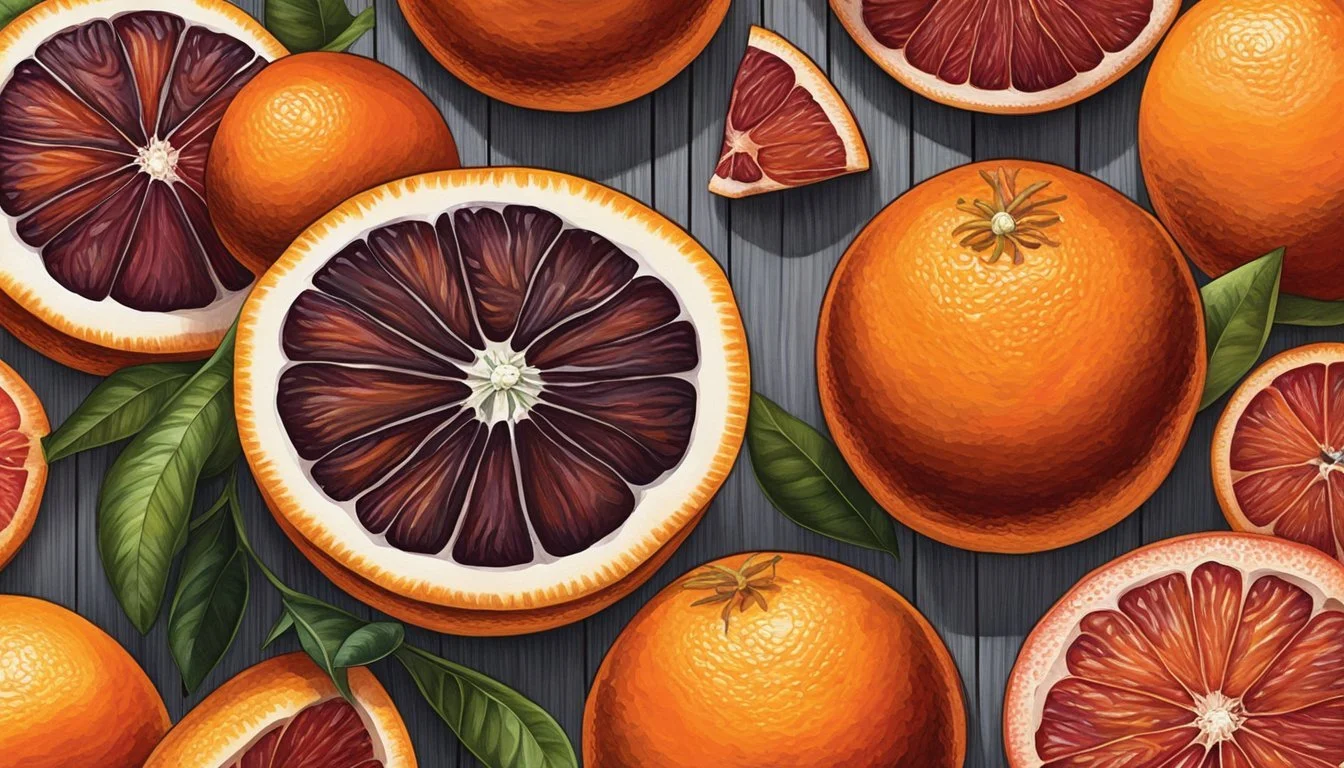How to Tell If a Blood Orange Is Ripe
Selecting the Best for Peak Sweetness
Determining the perfect ripeness of a blood orange is essential for enjoying its unique flavor, which blends the sweet tang of a regular orange with a hint of raspberry-like undertone. Blood oranges, unlike their navel or Valencia counterparts, showcase a distinctive crimson hue, which can give some insight into their ripeness, although color is not the only indicator. Several factors come into play to assess the ripeness of blood oranges, and understanding these can lead to the most flavorful experience.
The season plays a significant role in the ripeness of blood oranges, with peak seasons varying by region. While color and seasonal timing are helpful indicators, the ripeness of a blood orange is best judged through a combination of physical cues. These cues include the fruit's firmness, aroma, and skin texture. It is crucial to gently squeeze the blood orange to feel for a slight give, indicating that the fruit is ripe yet not overripe. Additionally, a ripe blood orange will have a fragrant smell and a skin that hints at the juiciness inside. Proper harvesting and storage practices are equally important to ensure that the blood oranges maintain their optimal flavor and texture from the grove to the kitchen table.
Key Takeaways
Assessing blood orange ripeness involves examining firmness, aroma, and skin texture.
Peak ripeness of blood oranges depends on regional seasonal variations.
Proper harvesting and storage extend the fruit's quality from the grove to the table.
Understanding Blood Oranges
In discerning the ripeness of blood oranges, it is essential to acknowledge their distinct varieties, the science behind their unique coloration, and the balance of flavors that signal maturity.
Varieties of Blood Oranges
Blood oranges are a particularly distinctive group within the citrus family, with several popular varieties. The 'Moro' is noted for its deep red flesh and excellent flavor, and it commonly ripens mid-season. The 'Tarocco' is favored for its sweetness and contains the highest Vitamin C content among blood orange types, while the 'Sanguinello' is late-ripening, with a shorter harvest time running until March.
The Unique Color of Blood Oranges
The red color in blood oranges is due to anthocyanins, a family of antioxidant pigments also found in other red, purple, and blue fruits. The presence and intensity of anthocyanin pigment vary with each variety and are influenced by specific growing conditions, such as temperature fluctuations between day and night. It is this pigment that hints at a blood orange’s ripeness, with the depth of redness often indicating a greater likelihood of maturity.
Flavor Profile: Sweetness and Tartness Combined
Blood oranges are celebrated for their perfect blend of sweetness with a hint of tartness, a flavor reminiscent of raspberries combined with traditional citrus notes. The balance between tart and sweet intensifies as the fruit ripens, and a ripe blood orange delivers a juicy, rich taste, which is both refreshing and complex. Taste is a reliable sign of ripeness, alongside color.
Optimal Seasons for Ripeness
The perfection of a ripe blood orange's taste and aroma is closely tied to specific seasonal periods. Understanding the intersection of climate and harvest times is key to enjoying the best quality fruit.
The Role of Climate in Blood Orange Ripeness
Blood oranges flourish in Mediterranean climates, where they benefit from the cool winter nights and warm, sunny days that are characteristic of regions like Spain, Italy, and California. These specific climate conditions are integral to developing the fruit's signature deep red color, sweet flavor, and distinct aroma. A true Mediterranean climate with its mild winters and hot summers is crucial to achieve optimal ripeness.
Typical Ripening Months
The blood orange season is relatively short compared to other citrus fruits. Typically, these oranges reach peak ripeness in the:
Winter: December and January are key months for initial ripening, with some variances depending on the year's specific weather conditions.
Early Spring: February often marks the end of the harvest season, although some varieties can extend into April, offering a slightly different flavor profile.
By focusing on these months, one can ensure they are enjoying blood oranges at their sweetest and most aromatic.
Selecting the Perfect Blood Orange
When choosing a blood orange, one should look for certain visual, textural, and aromatic signs to ensure the fruit is at its peak ripeness. Not only will these characteristics indicate a possibly sweeter and more flavorful experience, but they also signal a juicy, ripe fruit ready for consumption.
Visual Indicators of Ripeness
Color: A ripe blood orange should have a vibrant hue with red to deep crimson blush on the skin, although color alone can be misleading. One should also acknowledge the absence of green spots, which may suggest under-ripeness.
Skin Texture: The skin of the orange should feel firm yet should give slightly under pressure, indicating it is ripe without being overripe.
How to Perform a Taste Test
With permission, some vendors at farmers markets may allow a taste test.
If so, they can check for sweetness and tartness by sampling a small wedge. A balance of sweet and tart flavors usually points to a blood orange that is ripe.
Textures and Aroma as Ripeness Clues
Weight: Ripe blood oranges should feel heavy for their size, a good sign of juiciness.
Aroma: Smell is particularly telling—ripe oranges will have a strong, sweet aroma, especially at the stem end, hinting at the flavor experience within.
Harvesting and Storage Tips
Choosing the right moment to harvest blood oranges and implementing effective storage techniques are crucial for enjoying their optimal flavor and prolonging their shelf life.
Proper Harvesting Techniques
Blood oranges typically ripen on the tree from winter through early spring. Harvesting should occur when they exhibit a deep red hue and the stem begins to dry, an indication of peak ripeness. One should gently twist the fruit off the tree to avoid damaging the peel, which protects the juicy interior. They are ripe when they strike a balance between sweet and tangy, and the flesh is vibrant in color.
Storing Blood Oranges for Longevity
Once harvested, blood oranges can be stored effectively to maintain their freshness. For short-term storage, place the oranges at room temperature, away from direct sunlight. They should remain on the counter for up to a week. For longer storage, blood oranges can be kept in the refrigerator's crisper drawer to extend their life up to two weeks. Ensure they're dry to prevent mold or rot. Avoid freezing, as this can damage the peel and the juicy interior, affecting texture and flavor upon thawing.
Preparing and Serving Blood Oranges
Preparing blood oranges properly enhances their sweet and tart flavor profile, allowing them to be a versatile addition to a variety of dishes. From the way they are cut and peeled to their incorporation in recipes, every step matters in presenting the perfect citrus experience.
Peeling and Cutting for Maximum Enjoyment
When one is ready to enjoy a ripe blood orange, they should first start by rolling the fruit on a hard surface applying gentle pressure. This action helps to loosen the skin. Peeling can be done by slicing off the top and bottom of the orange and carefully making vertical cuts, sectioning off the skin while preserving as much of the fruit as possible. To cut a blood orange for direct consumption or to be included in a fruit salad, one might consider segmenting it into slices or wedges, ensuring all seeds are removed.
For those who prefer a more decorative presentation, blood oranges can be supremely sliced into rounds, creating an aesthetically pleasing addition to dishes and drinks. This method retains the juicy segments while displaying the deep red hue, characteristic of ripe blood oranges.
Incorporating Blood Oranges in Recipes
Blood oranges excel in both sweet and savory recipes with their distinct citrusy flavor adding a unique twist to traditional dishes.
Salads: Add a sweet and tart dimension by including fresh segments or thin slices of blood oranges in green or fruit salads.
Desserts: Utilize the juice or zest in cakes, tarts, or sorbets for a vibrant citrus note.
Meat Dishes: Complement rich meats like duck or pork with a blood orange reduction or glaze to balance the flavors.
Cocktails: Use the juice to craft colorful and refreshing cocktails or mix it with other fruit juices for a non-alcoholic punch.
Blood oranges not only inject a refreshing citrus flavor into recipes but their deep red color also provides a visually stunning element. This makes them an ideal ingredient to experiment with in a variety of culinary creations, from the simplest of salads to the most intricate of desserts.
Health Benefits and Nutritional Information
Blood oranges are not only visually striking with their distinctive crimson-hued flesh, but they also offer a robust nutritional profile and health benefits that extend beyond those of regular oranges.
The Nutritional Makeup of a Blood Orange
Blood oranges contain important nutrients that contribute to a healthy diet. A typical blood orange weighing approximately 130 grams contains:
Calories: 60-70
Sugar: 12-15g
Fiber: 3g
Vitamin C: Over 100% of the Recommended Daily Intake (RDI)
These fruits are also a good source of potassium, calcium, and thiamine. The presence of anthocyanins, which give blood oranges their unique color, also contributes to their antioxidant properties.
Health Benefits Linked to Blood Orange Consumption
Consuming blood oranges can provide considerable health benefits. Due to their high antioxidant content, blood oranges can help reduce oxidative stress and may lower the risk of chronic health issues such as:
Heart disease: Antioxidants may help improve heart health.
Cancer: Some studies link the consumption of blood oranges to a decreased risk of certain types of cancer.
Diabetes: The fiber content aids in blood sugar regulation.
The abundant vitamin C in blood oranges supports the immune system, while the presence of dietary fiber promotes digestive health. Additionally, research suggests that specific compounds in blood oranges may contribute to controlling weight gain and improving visual health.
Cultivation of Blood Oranges
Blood orange cultivation demands specific horticultural practices to ensure the production of high-quality fruit. Successful growth hinges on meeting the trees' climatic needs and safeguarding them against common threats.
Growing Conditions and Requirements
Blood oranges thrive in warm, Mediterranean-type climates. They need full sun exposure for most of the day to develop their signature flavor and color. The ideal temperature range lies between 55-85°F (13-29°C) outdoors. If grown indoors, they should be maintained around an average of 65°F (18°C) with sufficient light. These citrus trees prefer a slightly acidic to neutral soil with a pH range of 6.0-7.5. Consistent and regular watering is pivotal during the growing season, ensuring the soil is moist but not waterlogged to avoid root rot.
For optimal growth, blood orange trees require fertilization during active growth periods, typically with a fertilizer high in nitrogen. Proper pruning maintains tree shape and health, improving air circulation and sunlight exposure. Cultivars such as 'Tarocco', 'Moro', and 'Sanguinello' are popular for their taste and are often produced through grafting onto hardy rootstocks to enhance disease resistance and adaptability.
Common Pests and Diseases
Blood orange trees can be susceptible to a variety of pests and diseases. The most common pests include mites, aphids, and scale insects, which can be managed by inspecting the trees regularly and employing appropriate organic or chemical treatments. Diseases such as mold or rot can arise from excess moisture and poor air circulation.
To prevent the onset of diseases, it is crucial to maintain good orchard hygiene, like removing fallen leaves and fruit that can harbor pathogens. Farmers also strategically space the trees to ensure adequate air flow and apply mulch while keeping it away from the trunk to prevent moisture build-up which could lead to rot issues.
The History and Original Cultivation
The history of the blood orange is as rich and vibrant as the fruit's distinctive red flesh, marking its journey from ancient groves to global orchards.
Blood Orange Origin Stories
The blood orange (Citrus sinensis) is believed to have originated in either China or the Southern Mediterranean, where it spontaneously mutated from the standard sweet orange. Notable for its deep red interior, which is due to the presence of anthocyanins, a family of antioxidant pigments common to many flowers and fruit, but unusual in citrus fruits, the blood orange has three primary varieties: the Tarocco, native to Italy and particularly Sicily; the Moro, also found in Sicily; and the Sanguinello, which originated in Spain.
Expansion to the Mediterranean and Americas
The cultivation of blood oranges expanded significantly within the Mediterranean climates where they flourish. Sicily became a central point for the propagation of the Tarocco variety, renowned for its sweetness and vibrant color. During the 18th century, the blood orange began to spread to Spain, where the Sanguinello found favorable conditions. By the 19th century, the fruit made its way to the United States, finding a home in the conducive climates of California, Texas, and Florida. In these regions, all three variants have been cultivated, with the redder Moro variety becoming popular for its stronger berry-like flavor and deep red flesh. The Tarocco is preferred for being the sweetest of the blood oranges, while the Sanguinello is appreciated for its late-season ripening, extending the availability of blood oranges in the market.
Comparing Blood Oranges and Other Citrus Varieties
When choosing between blood oranges and other citrus fruits, understanding the differences in taste, appearance, and seasonal availability can help consumers make informed choices.
Blood Oranges vs. Navel Oranges
Blood oranges, such as Moro, Tarocco, and Sanguinello, are distinguishable from navel oranges by their deep red flesh, a result of the presence of anthocyanins. Navel oranges, named for their navel-like formation on the non-stem end, typically have a brighter orange skin and lack the red pigmentation found in blood oranges. Both blood and navel oranges are seedless, a desirable trait for fresh consumption.
In terms of flavor, blood oranges are often described as less acidic than navel oranges, with notes of raspberry and a hint of tartness. They are also considered juicier, making them ideal for both eating fresh and for use in juices.
Tasting Differences: Blood Oranges and Other Citrus
Citrus Taste Profile
Blood Orange
Taste Notes: Raspberry-like, slightly tart
Juiciness: Very Juicy
Navel Orange
Taste Notes: Sweet, less complex
Juiciness: Moderately Juicy
Tangerine
Taste Notes: Sweet-tart, aromatic
Juiciness: Juicy
Grapefruit
Taste Notes: Bitter-sweet, sharp
Juiciness: Juicy
Mandarins
Taste Notes: Sweet, less acidic
Juiciness: Moderately Juicy
Cara Cara
Taste Notes: Berry-like, sweet, low acidity
Juiciness: Juicy
Blood oranges like Cara Cara offer a more complex taste compared to other sweet oranges. The uniqueness comes from a raspberry-like flavor combined with traditional citrus sweetness.
Tangerines, grapefruits, and mandarins are other citrus family members with distinct flavors. Tangerines are less tart and more aromatic than blood oranges, while grapefruit offers a sharp bitterness that is absent in blood oranges. Mandarins, including varieties like Clementines, are sweeter and less acidic, making them quite different from the berry-like and slightly tart profile of blood oranges.







